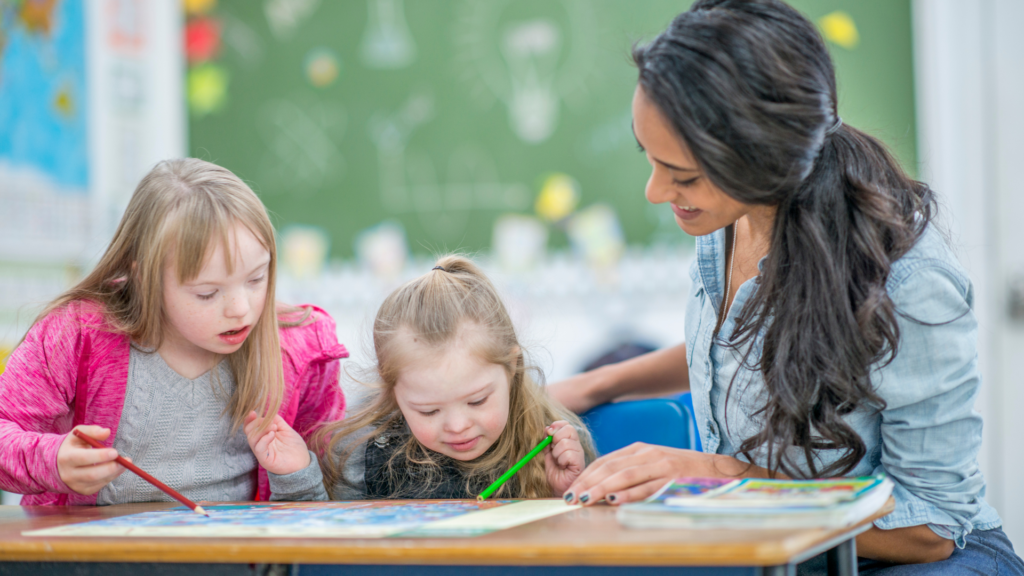Hey there, and welcome to our all-in-one guide for understanding the complex world of special needs and disabilities. If you’re a parent, a caregiver, or just someone who wants to learn more, you’re in the right place. We’ve got a lot to cover—from breaking down what these terms really mean, to navigating the healthcare maze for a diagnosis, all the way to the nitty-gritty roles that families and caregivers like you and me play every day. Think of this guide as your friendly companion on a journey that’s all about empowering you to be the best advocate for your loved one. So, grab a cup of coffee, make yourself comfortable, and let’s dive in.
Key Takeaways
- Special needs and disabilities are diverse, requiring personalized care and understanding for effective support.
- Physical, intellectual, sensory, and emotional disabilities each come with their own sets of challenges and treatments.
- Early signs, proper diagnosis, and assessment are crucial steps in receiving the most effective forms of support.
- Families and caregivers are invaluable, offering emotional support, daily care, and advocacy for their loved ones.
- Books, organizations, and online platforms provide essential resources for ongoing learning and support.
What Are Special Needs and Disabilities?

The Complexity of Terms
When we talk about special needs and disabilities, we’re entering a complex world with its own language, challenges, and, importantly, individuals who are as unique as their conditions. These terms often serve as an entry point into a labyrinth of healthcare, education, and social services that can seem overwhelming. But don’t worry; I’m here to guide you through it.
Definition of Special Needs
“Special needs” is a term you’ll often hear in educational settings, healthcare facilities, and social service agencies. But what does it really mean? At its core, special needs is an umbrella term used to describe a vast array of conditions that may require individualized support for a person to function at their best. This support can come in many forms: educational accommodations, healthcare interventions, or specialized equipment, to name just a few.
The Range of Special Needs
The scope of special needs is incredibly broad. It can encompass learning disabilities like dyslexia, emotional and behavioral disorders like ADHD, and physical conditions like cerebral palsy. The key takeaway is that special needs signify a requirement for extra assistance or accommodations, either temporarily or on a long-term basis.
Definition of Disabilities
The term “disabilities,” on the other hand, is more concrete. Defined by the Americans with Disabilities Act (ADA), a disability is a physical or mental impairment that significantly limits one or more major life activities. These activities include but are not limited to walking, talking, seeing, hearing, or learning.
Types of Disabilities
Disabilities can be categorized into several types:
- Physical Disabilities: These impact an individual’s ability to move freely. Examples include paralysis, muscular dystrophy, and multiple sclerosis.
- Sensory Disabilities: These affect one or more senses, like vision or hearing.
- Intellectual Disabilities: These affect cognitive functions and can influence how a person learns, reasons, or problem-solves.
- Psychiatric Disabilities: These include conditions like depression, anxiety disorders, and other mental health challenges that can affect daily living.
The Spectrum of Special Needs and Disabilities
If there’s one thing I’ve learned in my years as a caregiver, it’s that no two individuals are the same. It’s crucial to remember that both special needs and disabilities exist on a spectrum. What might be a minor hurdle for one person can be a significant obstacle for another.
Understanding the Individual
Each person’s needs are influenced by a range of factors, including the severity of their condition, their support network, and even their own personalities and preferences. For example, two children with the same diagnosis can have entirely different experiences and needs based on these variables.
The Importance of Personalized Care
Because of this variability, personalized care plans are often necessary. These plans take into account the unique circumstances and needs of the individual, aiming to provide the most effective support possible.
Common Types of Special Needs and Disabilities

The Diversity of Conditions
Understanding special needs and disabilities involves recognizing the incredible diversity of conditions that fall under these terms. From physical limitations to intellectual and emotional challenges, the landscape is vast. In this section, we’ll delve into the most common types of special needs and disabilities, providing a snapshot of each to help you better understand the nuances involved.
Physical Disabilities
When we think of disabilities, physical conditions often come to mind first. These are ailments that affect an individual’s mobility and physical capacity.
Mobility Issues
Examples include conditions like spinal cord injuries or limb differences that affect an individual’s ability to move around freely. Mobility issues can necessitate the use of assistive devices such as wheelchairs, crutches, or prosthetic limbs.
Muscular and Skeletal Conditions
Conditions like muscular dystrophy, arthritis, and osteogenesis imperfecta fall into this category. They primarily affect the muscles, joints, and bones, often requiring specialized medical care and physical therapy.
Intellectual Disabilities
Intellectual disabilities are those that impact cognitive function. While they are diverse, they share the common trait of affecting learning, reasoning, and problem-solving abilities.
Learning Disabilities
Dyslexia, dyscalculia, and dysgraphia are examples of learning disabilities. These conditions can make it challenging to read, write, or perform mathematical operations, despite having average to above
-average intelligence.
Developmental Disorders
Conditions like Down syndrome, autism spectrum disorders, and Fragile X syndrome are classified as developmental disorders. They affect cognitive and social development from an early age and often require a multidisciplinary approach for optimal support.
Sensory Impairments
Sensory disabilities affect one or more of the five senses: sight, hearing, taste, touch, and smell.
Visual Impairments
These range from partial sight to complete blindness. Individuals may require assistive technologies like screen readers or Braille to navigate daily life.
Hearing Impairments
Hearing impairments can range from mild to profound and may necessitate the use of hearing aids or cochlear implants.
Emotional and Behavioral Disorders
Last but not least, emotional and behavioral disorders affect an individual’s emotional well-being and social interactions.
Attention Disorders
Conditions like Attention Deficit Hyperactivity Disorder (ADHD) fall under this category. They can affect focus, attention, and impulsivity, often requiring behavioral therapy and, in some cases, medication.
Autism Spectrum Disorders
Autism Spectrum Disorders (ASD) affect social interaction, communication, and behavior. Early intervention and specialized educational programs can be beneficial.
The Importance of Proper Diagnosis and Assessment

The Journey to Understanding
The path to fully understanding and supporting a loved one with special needs or disabilities often begins with proper diagnosis and assessment. While it can be a challenging and emotionally charged process, it’s an essential step in ensuring the best possible care and support. In this section, we’ll explore the signs that may indicate a need for assessment, the general process for obtaining a diagnosis, and why early diagnosis is often pivotal.
Early Signs
Recognizing the early signs of special needs or disabilities can be both an art and a science. Sometimes, the signs are overt, like missing developmental milestones, while at other times, they can be subtle, like unusual behaviors or social challenges.
Developmental Delays
Children who show delays in reaching common developmental milestones, such as walking, talking, or potty training, may require further assessment. These delays can be early indicators of various conditions, including developmental disorders and physical disabilities.
Behavioral and Emotional Indicators
Unexplained mood swings, withdrawal from social activities, or aggressive behaviors can also be signs that something is amiss. Emotional and behavioral indicators often require a nuanced approach, involving healthcare providers who specialize in mental health.
Sensory Sensitivities
Over or under-responsiveness to sensory stimuli, like light, sound, or touch, can be early signs of sensory processing issues or disorders like autism.
Diagnosis Process
Navigating the healthcare system for a diagnosis can often feel like a maze. However, the journey is crucial for determining the most effective treatment and support strategies.
Screenings and Assessments
The process usually starts with initial screenings conducted by healthcare providers, followed by more in-depth assessments that may involve a variety of specialists, such as psychologists, neurologists, or occupational therapists.
Consultations and Second Opinions
After initial screenings and assessments, you may need to consult with additional healthcare providers for a more comprehensive diagnosis. Obtaining a second opinion is often advisable for complex or unclear cases.
Importance of Early Diagnosis
Early diagnosis is not just a buzzword; it’s often a game-changer that opens doors to early intervention and specialized support, significantly improving the quality of life for individuals and their families.
Benefits of Early Intervention
Early intervention can provide specialized support and educational programs, which are often most effective when started at a young age. This can lead to better outcomes in terms of educational achievement, social integration, and overall well-being.
Emotional and Psychological Benefits
Early diagnosis can also bring emotional relief to families, providing a framework for understanding challenges and behaviors. It helps demystify the condition, allowing for a targeted approach to care and support.
The Role of Families and Caregivers

The Heart of Support
If there’s one constant in the journey of caring for someone with special needs or a disability, it’s the invaluable role families and caregivers play. You are the advocates, the cheerleaders, and often the primary source of emotional and physical support. In this section, we’ll explore the multifaceted roles that families and caregivers assume and why each is crucial in its own right.
Emotional Support
Perhaps the most immediate role families and caregivers assume is that of an emotional anchor. Love, understanding, and emotional stability are often the most potent medicines.
The Healing Power of Presence
Simply being there, listening, and offering a shoulder to lean on can be incredibly therapeutic. Emotional support goes beyond words; it’s often about creating a safe space for your loved one to express themselves without judgment.
Emotional Intelligence and Caregiving
Understanding your own emotions and those of your loved one can make a significant difference in caregiving. Emotional intelligence helps in recognizing the needs that may not be verbally communicated, allowing for a deeper emotional connection.
Daily Care
On the more practical side of things, daily care involves a variety of tasks that facilitate the well-being of your loved one.
Medication and Health Management
This includes administering medication, coordinating with healthcare providers, and monitoring health metrics. It’s a role that demands meticulous attention to detail and, often, a good understanding of the medical landscape.
Activities of Daily Living (ADLs)
From bathing and grooming to meal preparation and mobility assistance, helping with ADLs is often a big part of the caregiving role. This is particularly true for caregivers of individuals with severe physical or intellectual disabilities.
Advocacy
Advocacy is an often-overlooked but critical role. Whether it’s fighting for educational rights or better healthcare services, advocacy is about standing up for your loved one.
Navigating Systems and Policies
Understanding educational, healthcare, and social systems is essential for effective advocacy. Knowing your rights and those of your loved one can empower you to demand the services and accommodations necessary for an improved quality of life.
Building a Support Network
Effective advocacy often involves creating or joining networks of like-minded individuals or organizations. Collective advocacy can be a powerful tool for systemic change.
Resources for Further Learning
The Power of Knowledge
The saying “knowledge is power” holds especially true in the world of special needs and disabilities. The more you know, the better you can advocate for your loved ones and provide them with the quality care they deserve. In this section, we’ll explore various resources that can help you on this lifelong journey of learning and advocacy.
Books and Articles
Reading can be an excellent way to deepen your understanding of specific conditions, caregiving strategies, and the emotional aspects of your role.
Academic Journals
For those who wish to delve into the scientific and medical aspects, academic journals can offer a wealth of up-to-date information. Journals like the “Journal of Autism and Developmental Disorders” or the “American Journal of Physical Medicine & Rehabilitation” can be great resources.
Popular Books
There are many well-written, accessible books aimed at families and caregivers. Titles like “The Out-of-Sync Child” by Carol Stock Kranowitz or “NeuroTribes” by Steve Silberman offer insightful perspectives.
Organizations and Support
Groups
Sometimes, the best resource can be another person who understands what you’re going through.
National and Local Organizations
Organizations such as The National Disability Rights Network, Easterseals, or local community centers often provide resources ranging from educational materials to support groups.
Online Support Groups
Online forums and social media groups can offer a sense of community and a wealth of shared experiences and advice. Just remember to verify any medical or legal advice with professionals.
Online Platforms
The internet is a double-edged sword. While it offers unparalleled access to information, not all of it is reliable.
Educational Websites
Websites from educational institutions or reputable organizations often offer articles, webinars, and free courses. Websites like Understood.org or the Center for Parent Information and Resources can be excellent starting points.
Apps and Tools
There are numerous apps designed to help with various aspects of caregiving, from medication reminders to educational games tailored for children with special needs. Always check reviews and perhaps consult with healthcare providers before using new digital tools.
Closing Thoughts
Wow, what a journey we’ve been on together, right? We’ve tackled everything from understanding what special needs and disabilities actually mean to the ins-and-outs of diagnosis, not to mention the superhero roles that families and caregivers like you take on every single day. And let’s not forget the valuable resources out there to keep you learning and growing in your role. Remember, this guide is just a starting point. Real expertise comes from living the experience, and let’s be honest, sometimes winging it and learning as you go.
Whether you’re just starting on this path or you’ve been walking it for years, I hope you’ve found something useful here. Advocacy starts with understanding, and understanding starts with taking the time to learn. You’ve done that today, and that’s something to be proud of. Keep going, keep learning, and most importantly, keep loving. You’re doing an incredible job, and you’re not alone on this journey.

